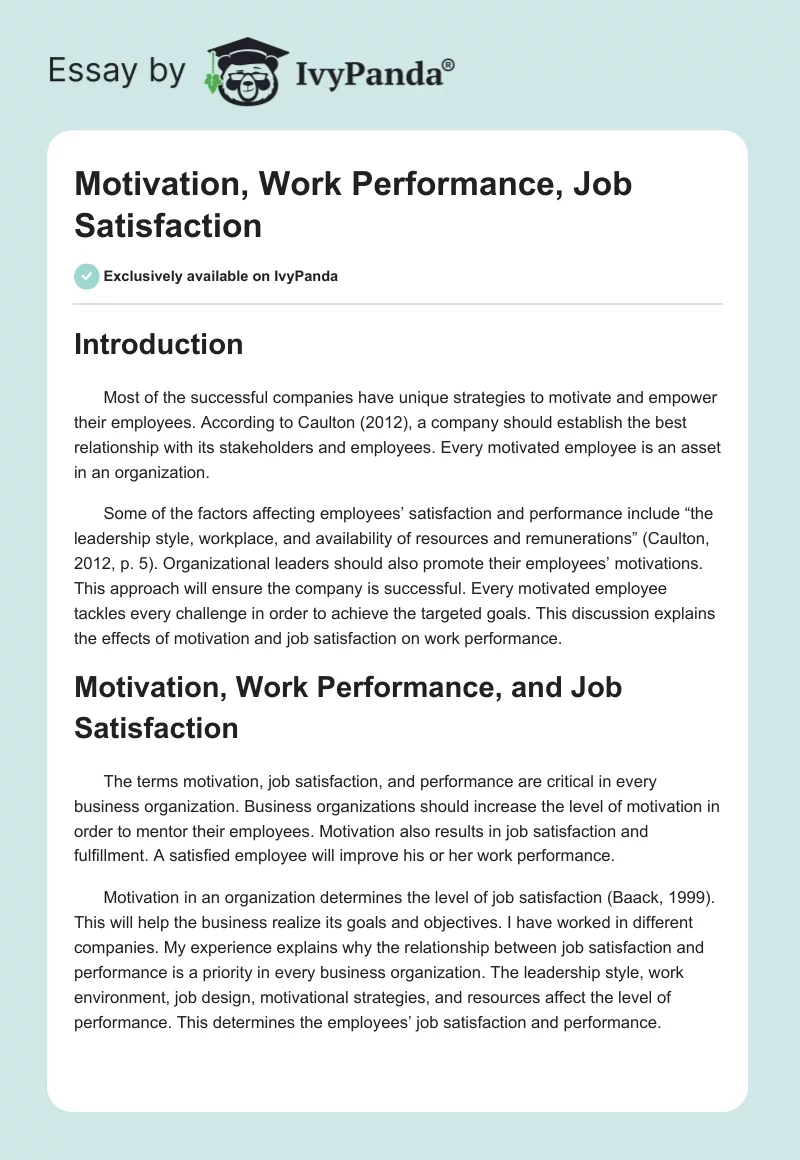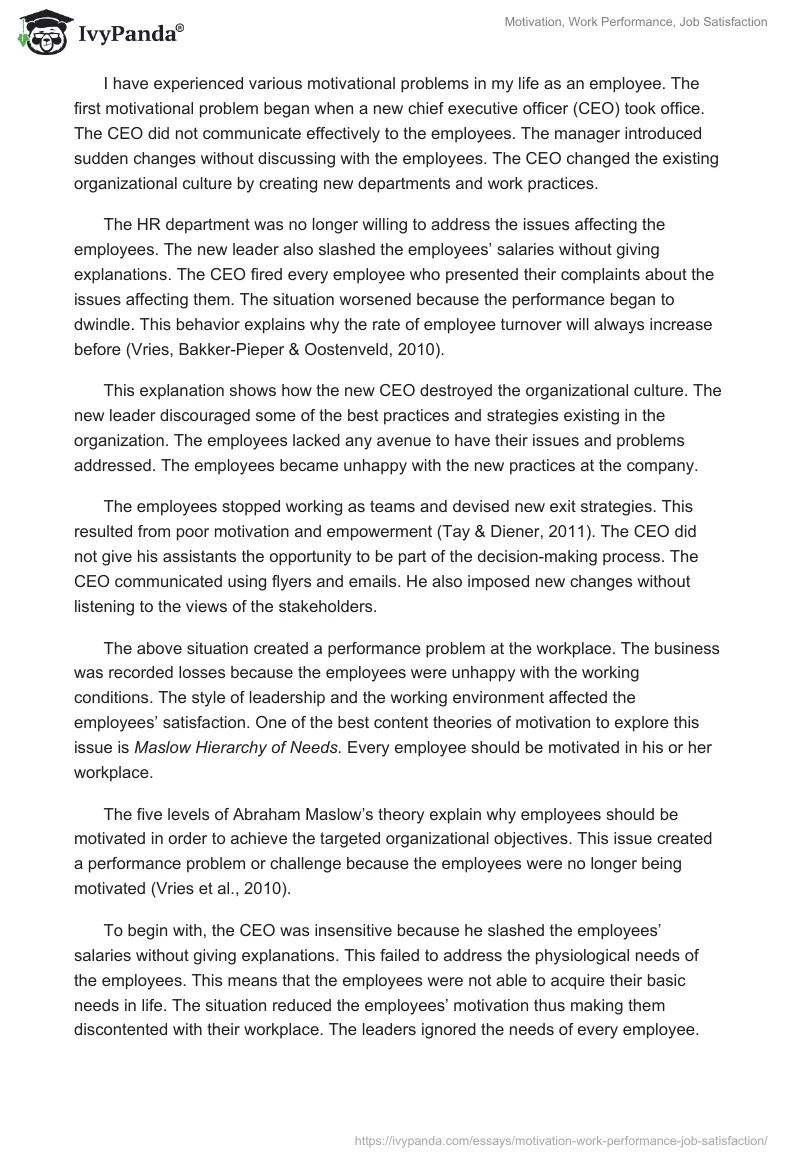Introduction
Most of the successful companies have unique strategies to motivate and empower their employees. According to Caulton (2012), a company should establish the best relationship with its stakeholders and employees. Every motivated employee is an asset in an organization.
Some of the factors affecting employees’ satisfaction and performance include “the leadership style, workplace, and availability of resources and remunerations” (Caulton, 2012, p. 5). Organizational leaders should also promote their employees’ motivations. This approach will ensure the company is successful. Every motivated employee tackles every challenge in order to achieve the targeted goals. This discussion explains the effects of motivation and job satisfaction on work performance.
Motivation, Work Performance, and Job Satisfaction
The terms motivation, job satisfaction, and performance are critical in every business organization. Business organizations should increase the level of motivation in order to mentor their employees. Motivation also results in job satisfaction and fulfillment. A satisfied employee will improve his or her work performance.
Motivation in an organization determines the level of job satisfaction (Baack, 1999). This will help the business realize its goals and objectives. I have worked in different companies. My experience explains why the relationship between job satisfaction and performance is a priority in every business organization. The leadership style, work environment, job design, motivational strategies, and resources affect the level of performance. This determines the employees’ job satisfaction and performance.
I have experienced various motivational problems in my life as an employee. The first motivational problem began when a new chief executive officer (CEO) took office. The CEO did not communicate effectively to the employees. The manager introduced sudden changes without discussing with the employees. The CEO changed the existing organizational culture by creating new departments and work practices.
The HR department was no longer willing to address the issues affecting the employees. The new leader also slashed the employees’ salaries without giving explanations. The CEO fired every employee who presented their complaints about the issues affecting them. The situation worsened because the performance began to dwindle. This behavior explains why the rate of employee turnover will always increase before (Vries, Bakker-Pieper & Oostenveld, 2010).
This explanation shows how the new CEO destroyed the organizational culture. The new leader discouraged some of the best practices and strategies existing in the organization. The employees lacked any avenue to have their issues and problems addressed. The employees became unhappy with the new practices at the company.
The employees stopped working as teams and devised new exit strategies. This resulted from poor motivation and empowerment (Tay & Diener, 2011). The CEO did not give his assistants the opportunity to be part of the decision-making process. The CEO communicated using flyers and emails. He also imposed new changes without listening to the views of the stakeholders.
The above situation created a performance problem at the workplace. The business was recorded losses because the employees were unhappy with the working conditions. The style of leadership and the working environment affected the employees’ satisfaction. One of the best content theories of motivation to explore this issue is Maslow Hierarchy of Needs. Every employee should be motivated in his or her workplace.
The five levels of Abraham Maslow’s theory explain why employees should be motivated in order to achieve the targeted organizational objectives. This issue created a performance problem or challenge because the employees were no longer being motivated (Vries et al., 2010).
To begin with, the CEO was insensitive because he slashed the employees’ salaries without giving explanations. This failed to address the physiological needs of the employees. This means that the employees were not able to acquire their basic needs in life. The situation reduced the employees’ motivation thus making them discontented with their workplace. The leaders ignored the needs of every employee.
The new leadership style did not the safety of every employee. As well, the CEO did not provide a healthy and safe working environment. The employees did not have a sense of belonging because the leaders did not fulfill their social needs. This explains why the teams began to disappear. The employees did not have the best communication processes. Some employees abandoned their positions because the leaders did not fulfill their social needs.
The next level is self-actualization. The leaders did not provide new opportunities to handle the problems or challenges affecting the company (Tay & Diener, 2011). The employees were unable to propose their projects or ideas. This explains why the CEO did not improve the competencies and skills of his employees. That being the case, Maslow’s theory explains how the situation created a major workplace problem.
Intervention Strategy
Maslow’s hierarchy theory can be used to motivate the employees and improve performance. The CEO should identify best practices and strategies to address the employees’ needs (Caulton, 2012). The best thing is to motivate the employees through each level as presented below.
Physiological Needs
The company should also offer competitive remunerations and salaries. The CEO should not slash the employees’ salaries. The strategy will ensure the workers have the means to purchase their basic needs (Caulton, 2012). There should be competitive salaries, insurance schemes, and childcare vouchers to motivate the employees.
Safety Needs
Most of the successful companies value the safety of their employees. The CEO should provide the employees with the best working environment. The leaders should take responsibility and observe the safety measures and rules at the workplace. The managers should “encourage the employees to have a proper work-life balance” (Caulton, 2012, p. 4).
Social Needs
Every employee should have a sense of belonging. The company should inform the employees about the organizational goal, mission, and vision. The CEO should have the best strategies to communicate with every employee or stakeholder. The company should also train and mentor every employee (Caulton, 2012). The approach will ensure the employees are motivated.
Self-actualization
The CEO can encourage and train its employees to tackle challenges. The company can encourage them to design their personal projects and execute them. There should be various mentorship and training programs to ensure the individuals realize their goals and potentials (Caulton, 2012).
Conclusion
Maslow’s theory encourages organizational leaders to reexamine their styles of leadership in order to address the needs of their employees. That being the case, the CEO and other leaders can use the theory to understand the problem. The theory also presents the best insights to correct the performance problem.
The above discussion encourages leaders to focus on the issues affecting every employee. The leaders can then fulfill the employee’s specific needs and expectations. The approach will increase the employees’ level of job satisfaction. The above discussion explains how the business’ relationship with its employees will always affect the level of motivation and performance.
Reference List
Baack, D. (1999). Organizational Behavior. New York: Dame Publishing.
Caulton, J. (2012). The Development and Use of the Theory of ERG: A Literature Review. Emerging Leadership Journeys, 5(1), 2-8.
Tay, L., & Diener, E. (2011). Needs and subjective well-being around the world. Journal of Personality and Social Psychology, 101(2), 354–365.
Vries, R., Bakker-Pieper, A., & Oostenveld, W. (2010). Leadership = Communication? The Relations of Leaders’ Communication Styles with Leadership Styles, Knowledge Sharing and Leadership Outcomes. Journal of Business and Psychology, 25(3), 367-380.


